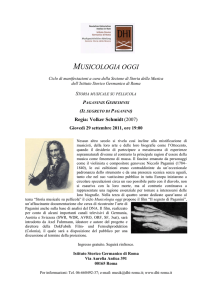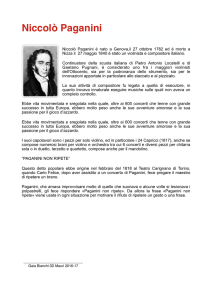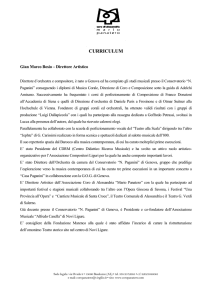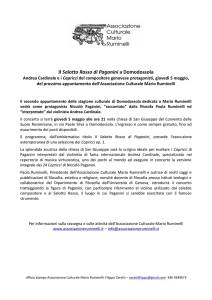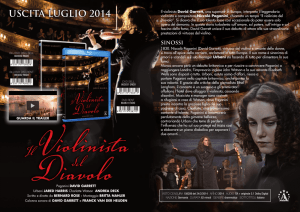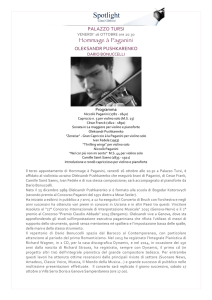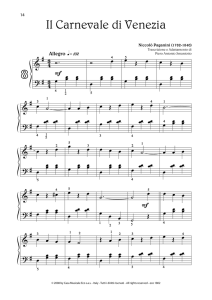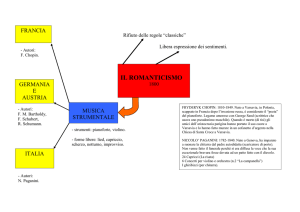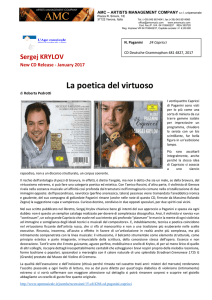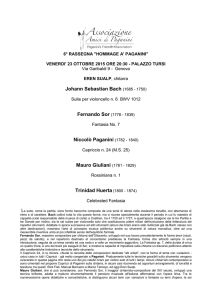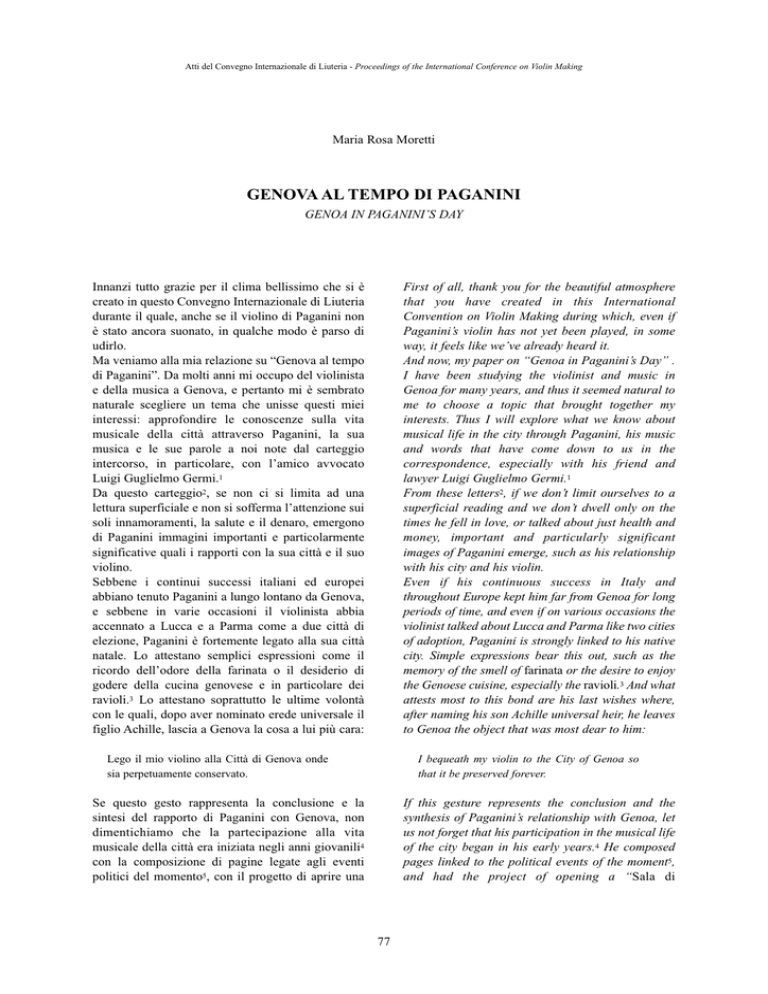
Atti del Convegno Internazionale di Liuteria - Proceedings of the International Conference on Violin Making
Maria Rosa Moretti
GENOVA AL TEMPO DI PAGANINI
GENOA IN PAGANINI’S DAY
Innanzi tutto grazie per il clima bellissimo che si è
creato in questo Convegno Internazionale di Liuteria
durante il quale, anche se il violino di Paganini non
è stato ancora suonato, in qualche modo è parso di
udirlo.
Ma veniamo alla mia relazione su “Genova al tempo
di Paganini”. Da molti anni mi occupo del violinista
e della musica a Genova, e pertanto mi è sembrato
naturale scegliere un tema che unisse questi miei
interessi: approfondire le conoscenze sulla vita
musicale della città attraverso Paganini, la sua
musica e le sue parole a noi note dal carteggio
intercorso, in particolare, con l’amico avvocato
Luigi Guglielmo Germi.1
Da questo carteggio2, se non ci si limita ad una
lettura superficiale e non si sofferma l’attenzione sui
soli innamoramenti, la salute e il denaro, emergono
di Paganini immagini importanti e particolarmente
significative quali i rapporti con la sua città e il suo
violino.
Sebbene i continui successi italiani ed europei
abbiano tenuto Paganini a lungo lontano da Genova,
e sebbene in varie occasioni il violinista abbia
accennato a Lucca e a Parma come a due città di
elezione, Paganini è fortemente legato alla sua città
natale. Lo attestano semplici espressioni come il
ricordo dell’odore della farinata o il desiderio di
godere della cucina genovese e in particolare dei
ravioli.3 Lo attestano soprattutto le ultime volontà
con le quali, dopo aver nominato erede universale il
figlio Achille, lascia a Genova la cosa a lui più cara:
First of all, thank you for the beautiful atmosphere
that you have created in this International
Convention on Violin Making during which, even if
Paganini’s violin has not yet been played, in some
way, it feels like we’ve already heard it.
And now, my paper on “Genoa in Paganini’s Day” .
I have been studying the violinist and music in
Genoa for many years, and thus it seemed natural to
me to choose a topic that brought together my
interests. Thus I will explore what we know about
musical life in the city through Paganini, his music
and words that have come down to us in the
correspondence, especially with his friend and
lawyer Luigi Guglielmo Germi.1
From these letters2, if we don’t limit ourselves to a
superficial reading and we don’t dwell only on the
times he fell in love, or talked about just health and
money, important and particularly significant
images of Paganini emerge, such as his relationship
with his city and his violin.
Even if his continuous success in Italy and
throughout Europe kept him far from Genoa for long
periods of time, and even if on various occasions the
violinist talked about Lucca and Parma like two cities
of adoption, Paganini is strongly linked to his native
city. Simple expressions bear this out, such as the
memory of the smell of farinata or the desire to enjoy
the Genoese cuisine, especially the ravioli.3 And what
attests most to this bond are his last wishes where,
after naming his son Achille universal heir, he leaves
to Genoa the object that was most dear to him:
Lego il mio violino alla Città di Genova onde
sia perpetuamente conservato.
I bequeath my violin to the City of Genoa so
that it be preserved forever.
Se questo gesto rappresenta la conclusione e la
sintesi del rapporto di Paganini con Genova, non
dimentichiamo che la partecipazione alla vita
musicale della città era iniziata negli anni giovanili4
con la composizione di pagine legate agli eventi
politici del momento5, con il progetto di aprire una
If this gesture represents the conclusion and the
synthesis of Paganini’s relationship with Genoa, let
us not forget that his participation in the musical life
of the city began in his early years.4 He composed
pages linked to the political events of the moment5,
and had the project of opening a “Sala di
77
“Sala di Emulazione Filarmonica” per promuovere
un “dilettevole trattenimento” e “formare ed
ampliare il numero degli amici dell’armonia”6, e con
la composizione di musiche per le feste di carnevale
che, numerose, si realizzavano a Genova.7 Tale
partecipazione era poi proseguita ad ogni suo ritorno
in città con la realizzazione di accademie in grado di
far vivere ai concittadini momenti di grande
entusiasmo.8 Questa, per esempio, parte della
cronaca apparsa sulla Gazzetta di Genova del 14
maggio 1824:
Emulazione Filarmonica” to promote “delightful
entertainment” and “to train and increase the
number of friends of harmony".6 Moreover, he
composed music for the nuomerous Carnival holiday
events that took place in Genoa during that time.7
Such participation was continued then upon each
return to the city with the creation of academies able
to have his fellow citizens live moments of great
enthusiasm.8 This for example, part of the local news
that appeared in the Gazzetta di Genova of May 14,
1824:
Paganini è comparso. Le sue prime note eccitarono l’ammirazione e la sorpresa; successe a
questa l’entusiasmo, e la sala echeggiò di
applausi. Ci sarebbe impossibile il far comprendere con parole quale espressione, quali suoni
inuditi egli tragga dal suo meraviglioso strumento
[...] né l’orecchio, né gli occhi possono seguitare
la volubilità, la rapidità della mano e delle note,
onde ne risulta una specie d’incanto in chi lo
guarda e lo ascolta.
Paganini has appeared. His first notes
provoked admiration and surprise; following
this, the enthusiasm and the room erupted into
applause. It is impossible to explain in words
what expression, what unheard sounds he
draws out of his marvelous instrument [...]
neither the ear nor the eyes can follow the
flightiness, the speed of his hand and the notes,
where the result is a kind of enchantment for
those who watch and listen.
Le ultime accademie effettuate a Genova sono quelle
realizzate al Teatro Carlo Felice il 30 novembre 1834
alla presenza di Carlo Alberto e famiglia9 e il 5
dicembre 1834 a favore dei poveri colpiti dal
colera.10
Anche durante gli anni della tournée europea (18281834) Paganini mantiene legami con la sua città: ciò
avviene in particolare attraverso la corrispondenza
con gli amici, e soprattutto con l’avvocato amico
Germi. A lui si rivolge per essere aggiornato sui
successi dei giovani violinisti genovesi: Camillo
Sivori innanzi tutto11, ma anche Agostino
Dellepiane, Luigi Riva, Stefano Mainetto e Giovanni
Serra; a Germi chiede informazioni sull’attività
teatrale12 e sui “virtuosi cantanti che dovranno
rappresentare nell’apertura del nostro nuovo teatro”
(Livorno, 14 agosto 1827); a lui confida il desiderio
di collaborare artisticamente alla vita del Teatro
Carlo Felice:
The last academies held in Genoa are those done at
the Carlo Felice Theatre on November 30, 1834 in
the presence of Carlo Alberto and his family9 and
on December 5, 1834 to help the poors, who were
victims of the cholera epidemic.10
Even during the years of the European tour (18281834), Paganini maintained ties to his city: this
happened especially through correspondence with
friends and above all with his friend the lawyer
Germi. He turned to him to be kept up to date on the
success of young Genoese violinists: first of all,
Camillo Sivori11, but also Agostino Dellepiane, Luigi
Riva, Stefano Mainetto and Giovanni Serra; he asks
Germi for information about theatrical12 activity and
about “virtuoso singers who should be performing at
the opening of our new theatre” (Livorno, August 14,
1827); he confides in his friend about his desire to
collaborate artistically in the life of the Carlo Felice
Theatre:
Del teatro nuovo di Genova sarei volentieri
(dopo il mio giro di tre anni circa) direttore
d’orchestra, non solo, ma degli spettacoli in
massa, tanto per la scelta dei virtuosi come
degli spartiti.
Se mi sarà dato formar parte dell’armonia nella
fausta apertura del nostro nuovo teatro,
giubilerò non poco.13
I would gladly be the conductor of the new
theatre in Genoa (after my approximately threeyear trip), not only, but of the performances en
masse, as much for the choice of the virtuoso as
for the choice of scores.
If I were to be given the chance to be a part of
the harmony of the auspicious opening of our
new theatre, I would rejoice, and not a little.13
78
Atti del Convegno Internazionale di Liuteria - Proceedings of the International Conference on Violin Making
A questo punto mi chiedo quali sarebbero stati i
vantaggi per Genova se Paganini avesse potuto
effettivamente occuparsi del Carlo Felice e se il
teatro avesse saputo fare proprie le innovazioni da
lui progettate su incarico della duchessa Maria
Luigia per l’Orchestra Ducale di Parma.14
Riprendo ed insisto sul gesto generoso di Paganini
nei confronti di una città che non sempre gli è stata
favorevole perché mi ha sempre colpito il rapporto
particolare che Niccolò ha avuto con il suo “violino
cannone”, come chiamava affettuosamente il
compagno di tanti successi.
Lasciamo dunque la parola a Paganini perché da essa
emerge che nel parlare dei suoi successi il violinista
non fa riferimento a se stesso, ma attribuisce il
merito al suo violino, del quale mette in luce le
caratteristiche del suono e la “magia”. Questi alcuni
esempi tratti dall’epistolario:
At this point I wonder about the advantages for
Genoa if Paganini had effectively been able to be in
charge of the Carlo Felice and if the theatre had only
known how to make its own the innovations planned
by him upon request of the Duchess Maria Luigia for
the Ducal Orchestra of Parma.14
I will take up once again and insist upon Paganini’s
generous gesture with regard to a city that was not
always favorable to him, because it has always
struck me, this special relationship that Niccolò had
with his “cannon violin” as he affectionately called
it his companion in so many moments of success.
So let’s have Paganini speak, because what emerges
from his words is that in talking about his success,
the violinist never refers to himself, but attributes the
merit to his violin, about which he emphasizes the
characteristics of the sound and the “magic”. These
are some examples taken from his letters:
Qua desiderano risentire il mio violino
(Torino, 20 dicembre 1817)
Here they want to hear my violin again
(Turin, December 20, 1817)
So che un giornale parla del mio violino
(Roma, 20 febbraio 1819)
I know a newspaper is talking about my violin
(Rome, February 20, 1819)
Il mio violino è magico da per tutto
(Napoli, 26 marzo 1819)
My violin is magic everywhere
(Naples, March 26, 1819)
Avendo inteso il mio violino in un’accademia
(Roma, 27 marzo 1825)
Having heard my violin in an academy
(Rome, March 27, 1825)
Conviene ch’io faccia sentire la mia musica e il
mio violino
(Lipsia, 16 ottobre 1829)
It’s better that I let my music and my violin be
heard
(Leipzig, October 16, 1829)
Avrò l’onore di far sentire il mio violino a
codesto Teatro Gran Ducale
(Francoforte, 29 gennaio 1831)
I will have the honor of making my violin heard
in this Grand Ducal Theatre
(Frankfurt, January 29, 1831)
Non ti parlerò della magia che scaturì dal mio
strumento nel concerto dato qui il 5
(Carlsruhe, 8 febbraio 1831)
I will not speak to you of the magic that
springed from my instrument in the concert
given here on the 5th
(Karlsruhe, February 8, 1831)
Non ci voleva che il mio violino per vederlo [il
teatro] sempre pieno, stante che il mio suono,
per quanto mi dicono, è divenuto più che mai
miracoloso
(Londra, 17 settembre 1832)
All it took was my violin to see it [the theatre]
always full, considering that my sound, as they
tell me, had become more miraculous than ever
(London, September 17, 1832)
Persino gli innamoramenti sono per lui legati al
suono del suo Guarneri e al modo di suonarlo; e
Even falling in love, for Paganini, is linked to the
sound of his Guarneri and his way of playing it; he
79
does not hesitate to state:
Paganini non esita ad affermare:
L’effetto del mio suono è talmente magico che
fa impazzire i più alti personaggi nonché le più
gentili signore
(Carlsruhe, 12 dicembre 1829)
The effect of my sound is so magic that it makes
both high-ranking personalities and ladies go
mad
(Karlsruhe, December 12, 1829)
È vero che quando sentono il mio linguaggio
musicale, l’oscillazione delle mie note le fa
tutte piangere
(Baden - Baden, 30 agosto 1830)
It’s true that when they hear my musical
language, the vibrato of my notes makes them
all cry
(Baden - Baden, August 30, 1830)
Non solo. Col passare del tempo i riferimenti al suo
violino si fanno ancor più significativi, e Paganini
accenna al “fanatismo diabolico” prodotto dal suo
strumento (Manchester, 15 gennaio 1832) sino a
giungere alla ormai arcinota definizione:
Not only. With the passage of time, the references to
his violin become even more important and Paganini
makes reference to the “diabolical fanaticism” his
instrument produces (Manchester, January 15, 1832)
until he reaches what is by now the most famous
definition:
ottenni col mio procedere ed il mio Cannone
violino […] il mio trionfo
(Londra, 16 luglio 1833).
I obtained with my performance and my
Cannon violin […] my triumph
(London, July 16, 1833).
Altri aspetti evidenziano invece più direttamente
alcune caratteristiche della vita musicale della città.
Ancora una volta ci affidiamo alle composizioni
pervenute e alla corrispondenza intercorsa con
Germi dal 1818 al 1820.
Nel primo caso il riferimento d’obbligo è ai
quartetti con chitarra dedicati a personaggi della
nobiltà genovese, la marchesa Catterina Raggi
Pallavicino (M.S. 34) e i marchesi Filippo Carrega
(M.S. 35) e Gio.Batta Crosa (M.S. 42):
testimonianza di amicizia ma anche segno che la
nobiltà genovese era attenta alla musica e in grado
di apprezzarla ed eseguirla.
Nel secondo caso le lettere di Paganini a Germi
confermano il particolare e stretto rapporto che
univa i due amici: a lui Paganini annuncia la
composizione di nuovi quartetti con chitarra,
comunica le caratteristiche dei brani e le modalità
esecutive, chiede giudizi e consigli, formula
apprezzamenti per le esecuzioni che l’amico
realizza nella propria abitazione.15
Attraverso queste lettere apprendiamo che a
Genova si “fa musica” e che, in anni dominati
dall’interesse per il melodramma, nelle case
genovesi si coltiva la musica strumentale con
private esecuzioni cameristiche.16
Questa realtà conduce alla necessità di individuare
quali musicisti, che nel corso degli anni non
Other aspects more directly underscore some
characteristics of the musical life of the city. Once
again we entrust ourselves to the compositions that
have been passed down and the correspondence with
Germi from 1818 to 1820. In the first case, the
obligatory reference is to the quartets with guitar
dedicated to figures of the Genoese nobility, the
Marquise Catterina Raggi Pallavicino (M.S. 34) and
the Marquises Filippo Carrega (M.S. 35) and
Gio.Batta Crosa (M.S. 42). They are evidence of
friendship but also a sign that the Genoese nobility
was attentive to music and able to appreciate and
play it. In the second case, Paganini’s letters to
Germi confirm the special and tight relationship that
united the two friends: Paganini announces to him
the composition of new quartets with guitar; he
communicates the characteristics of the pieces and
the way to play them; he asks for opinions and
advice; he formulates compliments for the
performances that the friend organizes in his own
home.15 Through these letters we learn that in
Genoa, music is “being made” and that in years
dominated by the interest for melodrama, in Genoese
homes, instrumental music is being cultivated with
private chamber music performances.16
This situation brings us to the need of identifying
which musicians, who over the course of the years
were not always the same ones, participated in the
80
Atti del Convegno Internazionale di Liuteria - Proceedings of the International Conference on Violin Making
dovettero essere sempre gli stessi, partecipavano
alle esecuzioni in casa Germi.
Innanzi tutto lo stesso Germi, avvocato di
professione ma con notevoli competenze musicali e
capacità esecutive. A lui Paganini dedica sei
quartetti per archi e chitarra (M.S. 36-41) e le
Variazioni sul Barucabà per violino e chitarra
(M.S. 71), a lui invia il segreto degli armonici17 e
con lui discute di musica e commercia strumenti
musicali, archetti e corde.18 In secondo luogo Luigi
Riva, del quale non abbiamo molte informazioni,
ma che da Paganini è definito come “il più bravo
armonista e professore di chitarra” (Napoli, 29
maggio 1820).19 Pur tenendo presente che una sorta
di campanilismo poteva portare il violinista a
parlare bene dei suoi amici genovesi, il suo giudizio
è da tenere presente soprattutto quando afferma che
Riva è “l’unico” per i suoi quartetti.
Tra i violinisti che compaiono più frequentemente
incontriamo inoltre Agostino Dellepiane e
Giovanni Serra. Il primo, allievo di Paganini e a sua
volta insegnante di Sivori nonché dedicatario delle
Sei Sonate per violino e chitarra (M.S. 26 - op. 2
dell’edizione Ricordi del 1820), fu primo violino al
Teatro Carlo Felice e insegnante al liceo musicale
che porterà il nome del grande violinista
genovese.20
Il secondo, particolarmente lodato da Paganini21, fu
primo violino direttore d’orchestra al Teatro S.
Agostino e poi al Carlo Felice, insegnante di Sivori
per l’armonia ed il contrappunto e direttore del
liceo musicale dal 1851 al 1872.22
Anche Camillo Sivori ha partecipato e vivacizzato
la vita musicale genovese.23 Nel 1824, all’età di
nove anni, tiene in casa dello zio Antonio una
accademia privata. In programma, oltre ai Cantabili
e valtz e alle Sonatine per violino e chitarra (M.S.
45, 124-129), la Sonata con variazioni per violino,
viola, chitarra e violoncello (M.S. 132)24: Camillino
suona in quartetto con Dellepiane alla viola,
Paganini alla chitarra e Pietro Casella25 al
violoncello.
Esecuzioni cameristiche saranno poi effettuate da
Sivori ad ogni ritorno nella città natale26,
contribuendo a formare il gusto per la musica da
camera ed in particolare per quella dei grandi
compositori viennesi. A questo proposito non
possiamo non ricordare la lettera del 20 agosto
1839 nella quale Germi scrive a Paganini: “Serra ti
ringrazia suona con Sivori dei quartetti d’Haydn in
mia casa: sono pur belli”.27
performances at Germi’s home. First of all Germi
himself was a lawyer by profession but with
remarkable musical skill and performance ability.
Paganini dedicates six quartets for strings and guitar
to him (M.S. 36-41) and the Variations on Barucabà
for violin and guitar (M.S. 71).
He sends him the secret of the harmonics17 and
speaks with him about music.
With Germi, Paganini trades in musical instruments,
bows and strings.18 In the second place there is Luigi
Riva, a figure about whom we do not have much
information, but whom Paganini defines as “the best
harmonist and guitar teacher” (Naples, May 29,
1820).19
Even if we consider that a kind of local pride might
have made the famous violinist speak well of his
Genoese friends, his opinion should be kept in mind
above all when he states that Riva is “the only one”
for his quartets.
Among the violinists who appear most frequently, we
find Agostino Dellepiane and Giovanni Serra.
The first, pupil of Paganini and in turn teacher of
Sivori, as well as the person to whom the Six Sonatas
for violin and guitar are dedicated to (M.S. 26 - op. 2
of the Ricordi edition of 1820), he was first violinist
at the Carlo Felice Theater and teacher in the
musical high school that will bear the name of the
great Genoese violinist.20
The second, especially praised by Paganini21, was
the first violinist and conductor at the S. Agostino
Theatre and then at the Carlo Felice. He was Sivori’s
teacher for harmony and counterpoint and director
of the musical high school from 1851 to 1872.22
Even Camillo Sivori participated and made the
musical life in Genoa23 livelier. In 1824, at the age of
nine, he held a private academy in his uncle
Antonio’s home.
On the program, in addition to the Cantabili e valtz
and to the Sonatine for violin and guitar (M.S. 45,
124-129), the Sonata con variazioni for violin, viola,
guitar and cello (M.S. 132)24: Camillino played in a
quartet with Dellepiane on the viola, Paganini on the
guitar and Pietro Casella25 on the cello.
Following, Sivori will perform chamber music upon
every return to his native city26, contributing to shape
the taste for chamber music, especially by the great
Viennese composers.
On this point we cannot but recall the letter dated
August 20, 1839 in which Germi writes to Paganini:
“Serra thanks you and is playing Haydn’s quartets
with Sivori at my house: they’re also very nice”.27
81
1
2
3
4
5
6
7
8
9
10
11
12
13
14
15
16
17
18
19
20
21
Notizie sulla sua vita in (Information on his life in) LUIGI TOMMASO BELGRANO, Imbreviature di Giovanni Scriba, Genova, Tip. del
Regio Istituto dei Sordo-Muti, 1882, p. 366.
Cfr. ARTURO CODIGNOLA, Paganini intimo, Genova, Municipio di Genova, 1935; NICCOLÒ PAGANINI, Epistolario, a cura di
EDWARD NEILL, Genova, Comune di Genova, 1982; EDWARD NEILL, Registro di lettere 1829, Genova, Graphos, 1991.
Un nuovo epistolario è in preparazione a cura di Roberto Grisley: il primo volume è di prossima pubblicazione.
A new edition of the correspondence is forthcoming, edited by Roberto Grisley: the first volume is in print.
“Rammentando le grazie della signora Cammilletta nonché le preziose vivande preparate dalla vezzosa Tonietta” (Napoli, 17 dicembre
1825); “un luogo di delizia mi sarà carissimo per farci dei Duetti e Quartetti musicali, coi ravioli annessi […] Se madama Camilla desidera
ch’io abbia la consolazione di rivederla e gustare i suoi ravioli quali rammento squisitissimi” (Baden-Baden 30 agosto 1830).
“Remembering the grace of signora Cammilletta as well as the precious food prepared by the charming Tonietta” (Naples, December 17,
1825); “a place of delight, it will be so sweet for me to play the duets and quartets, with the connected ravioli […] If Madame Camilla
so desires that I have the consolation of seeing her again and tasting her ravioli which as I recall are exquisite” (Baden-Baden, August
30, 1830).
Le notizie sui suoi maestri sono a tutt’oggi scarse. Esse risalgono essenzialmente all’autobiografia dettata a Peter Lichtenthal nel marzo
del 1828, prima della partenza per Vienna, e pubblicata sulla Allgemeine Musikalische Zeitung (n. 20, 1830, coll. 324 sgg.), alla biografia
scritta da Schottky (JULIUS MAX SCHOTTKY, Paganini’s Leben und Treiben als Künstler und als Mensh..., Prag, Taussig & Taussig,
1830) e alle informazioni riportate dal periodico genovese Avvisi (31 maggio e 6 dicembre 1794 e 30 maggio 1795). Per un
approfondimento di queste notizie attraverso i documenti d’archivio si veda MARIA ROSA MORETTI – ANNA SORRENTO, Notizie
biografiche sui primi maestri genovesi di Niccolò Paganini, in Paganini, Genova e la musica. Saggi in onore di Alma Brughera Capaldo,
a cura di GIUSEPPE ISOLERI, MARIA ROSA MORETTI, ENRICO VOLPATO, Genova, San Marco dei Giustiniani, 2003, pp. 33-48.
Information about his teachers are still today scarce. Essentially we refer to the autobiography dictated to Peter Lichtenthal in March
1828, before leaving for Vienna, and published in the Allgemeine Musikalische Zeitung (n. 20, 1830, pp. 324 sgg.), and to the biography
written by Schottky (JULIUS MAX SCHOTTKY, Paganini’s Leben und Treiben als Künstler und als Mensh..., Prag, Taussig & Taussig,
1830) and to the information reported by the Genoese newspaper Avvisi (May 31 and December 6, 1794 and May 30, 1795). To explore
in-depth this information through archival documents, see MARIA ROSA MORETTI – ANNA SORRENTO, Notizie biografiche sui primi
maestri genovesi di Niccolò Paganini, in Paganini, Genova e la musica. Saggi in onore di Alma Brughera Capaldo, edited by GIUSEPPE
ISOLERI, MARIA ROSA MORETTI, ENRICO VOLPATO, Genova, San Marco dei Giustiniani, 2003, pp. 33-48.
La Carmagnola con variazioni per violino e chitarra M.S. 1 e l’Inno patriottico per violino M.S. 81.
MARIA ROSA MORETTI, Niccolò Paganini a Genova: 1803-1804, in “Quaderni del Civico Istituto di Studi Paganiniani”, 13 (2001),
pp. 38-47.
Cfr. nota precedente. Per le feste del carnevale genovese Paganini compose i Divertimenti carnevaleschi per due violini e basso M.S. 4 e
le Sei Nuovissime Alessandrine per due violini, clarinetto, due corni e basso M.S. 131.
See preceding note. For the carnival feast days in Genoa Paganini composed the Divertimenti carnevaleschi for two violins and bass M.S
4 and the Sei Nuovissime Alessandrine for two violins, clarinet, two horns and bass M.S. 131.
Dopo gli esordi del 1794-1795 trascorrono quasi venti anni prima che nel 1814 Paganini sia nuovamente ascoltato, ormai famoso, dai
concittadini. Paganini tornerà a Genova ancora nel 1815, 1824, 1827, 1834.
After the debuts in 1794-1795 almost twenty years passed before Paganini was heard once again by his fellow citizens in 1814, by now
very famous. He will return to Genoa again in 1815, 1824, 1827, 1834.
In ringraziamento, il Corpo Decurionale fa omaggio a Paganini di una medaglia appositamente coniata.
In thanks, the Corpo Decurionale will pay homage to Paganini with a medal that they coin.
Alcuni giorni dopo, a sollievo delle famiglie colpite dall’epidemia, Paganini offrirà ancora 1000 lire (A. CODIGNOLA, cit., p. 427 nota).
A few days later, for relief for the families hit by the epidemic, Paganini will again offer 1000 lire.
“Come ha suonato il piccolo nell’oratorio?” (Villanuova, 26 febbraio 1824); “Amerei sapere i progressi di Camillino Sivori” (Trieste, 27
novembre 1824).
“How did the little one play at the oratory?" (Villanuova, February 26, 1824); "I would like very much to know about the progress of little
Camillo Sivori” (Trieste, November 27, 1824).
“Dammi le notizie intorno ai teatri” (Napoli, 22 novembre 1825).
“Give me the news about theatres”(Naples, November 22, 1825).
Lettere da Napoli (12 aprile 1825) e da Milano (30 novembre 1827).
Letters from Naples (April 12, 1825) and from Milan (November 30, 1827).
Cfr. MARZIO DELL’ACQUA, Paganini e l’orchestra ducale di Parma. Protagonisti e vicende di una riforma musicale fra potere
burocrazia e tradizione, in Orchestre in Emilia-Romagna nell’Ottocento e nel Novecento, a cura di MARCELLO CONATI e MARCELLO
PAVARANI, Parma, Orchestra Sinfonica dell'Emilia-Romagna, 1982, pp. 145-171 e GIAN PAOLO MINARDI, L’orchestra a Parma. Un
prestigio europeo e il suo progressivo declino, Ivi, pp. 75-144.
Le frasi più significative sono riportate nel Catalogo tematico delle musiche di Niccolò Paganini, a cura di MARIA ROSA MORETTI –
ANNA SORRENTO, Genova, Comune di Genova, 1982, pp. 139-140.
The most important phrases are reported in the Catalogo tematico delle musiche di Niccolò Paganini, edited MARIA ROSA MORETTI –
ANNA SORRENTO, Genova, Comune di Genova, 1982, pp. 139-140.
FLAVIO MENARDI NOGUERA, “Amami. Il tuo amico, Luigi Guglielmo Germi”, in Paganini, Genova e la musica cit., pp. 59-75.
WARREN KIRKENDALE, Segreto comunicato da Paganini, in “Journal of the American Musicological Society”, XVIII, n. 3 (1965),
pp. 394-407; PHILIPPE BORER, Paganini and the “Philosophy of the violin” Aspects of a musical language, in “Quaderni del Civico
Istituto di Studi Paganiniani”, 10 (1998), pp. 42-46.
In questa sede è impossibile citare tutte le volte che Paganini discute con Germi di liuteria; si rinvia pertanto genericamente a N.
PAGANINI, Epistolario cit.
In this conference it is impossible to cite all the times Paganini discussed violinmaking with Germi. See in general N. PAGANINI,
Epistolario cit.
Sebbene Paganini parli di Luigi Riva come di un chitarrista, il suo nome compare alcuni anni dopo tra i violinisti dell’orchestra del Teatro
Carlo Felice.
Even if Paganini talks about Luigi Riva as a guitarist, his name appears a few years later among the violinists of the Carlo Felice Theatre.
SALVATORE PINTACUDA, Il Conservatorio di Musica Nicolò Paganini di Genova. Storia e documenti dalle origini ai giorni nostri,
Genova, Sabatelli, 1980, p. 134.
Ricordiamo la lettera del 5 agosto 1839 nella quale Paganini, tra le altre cose, dichiara “riunirsi in quel maestro di cappella scienza
82
Atti del Convegno Internazionale di Liuteria - Proceedings of the International Conference on Violin Making
22
23
24
25
26
27
profonda di contrappunto di cui diede saggi luminosi; esperienza somma per la direzione delle opere in musica come primo violino”.
We recall the letter of August 5, 1839 in which Paganini, among other things, declares “finding in that kappelmeister both the
profoundknowledge of counterpoint about which he gave us many illuminating essays; and tha most supreme experience for directing
musical works as first violinist”.
S. PINTACUDA cit., pp. 32-34, 131.
FLAVIO MENARDI NOGUERA, Camillo Sivori. La vita, i concerti, le musiche, Genova. Graphos, 1991.
MARIA ROSA MORETTI – ANNA SORRENTO, Dall’archivio Sivori nuovi autografi paganiniani, in “Quaderni del Civico Istituto di
Studi Paganiniani”, 8 (1996), pp. 27-33.
Come è noto i Cantabili e valtz e le Sonatine furono composti per il “Camillino” e sono stati da Paganini pedagogicamente corredati di
arcate e diteggiatura nonché ordinati secondo difficoltà progressive “tanto riguardo al possesso dell’istrumento, quanto per formare
l’anima del Camillino”.
As is known, the Cantabili e valtz and the Sonatine were composed for the little “Camillino” and were pedagogically supplied with
bowings and fingerings by Paganini as well as ordered progressively according to difficulty “as much with respect for possession of the
instrument as for shaping the soul of Camillino”.
Capostipite di una famiglia di musicisti tra i quali il figlio Cesare, anch’egli violoncellista, e il nipote, il noto compositore Alfredo Casella.
Head of a family of musicians among whom the son Cesare, also a cellist, and grandson, the famous composer Alfredo Casella.
F. MENARDI NOGUERA, Camillo Sivori cit.
F. MENARDI NOGUERA, “Amami. Il tuo amico, Luigi Guglielmo Germi” cit., p. 68.
83
Maria Rosa Moretti, pianista.
Studiosa di Paganini: è coautrice con Anna Sorrento del ‘Catalogo
tematico delle musiche di Niccolò Paganini’ e dei successivi
aggiornamenti.
Svolge attività musicologica e di ricerca, partecipa a convegni
internazionali, pubblica libri e saggi in particolare sulla storia
della musica a Genova. È stata docente di Storia ed Estetica
musicale al Conservatorio N. Paganini di Genova.
Maria Rosa Moretti, pianist.
Paganini expert: co-author, along with Anna Sorrento, of the
‘Catalogo tematico delle musiche di Niccolò Paganini’ and of its
revisions. Musicologist and researcher, she participates to
international conferences, she publishes books and essays, in
particular concerning the history of music in Genoa. She has been
professor of History and Aesthetics of Music at the Conservatory
N. Paganini of Genoa.
76

